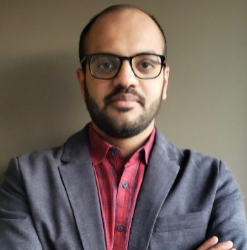
Hrishikesh Joshi is a technology leader at Okta, a company known for its work in identity and access management. He specializes in designing systems that are both secure and able to scale with the company's needs. In this interview, Hrishikesh Joshi shares his career journey, the challenges he faces, and his thoughts on emerging technologies.
Q: How did you become an enterprise architect at Okta, and how have your past experiences shaped your work?

: Throughout my career, I've found great satisfaction in problem-solving across various domains—be it through technology, people management, process optimization, or data analysis. My professional journey has spanned multiple roles, including product management, engineering development, and, more recently, architecture. In each of these positions, the common thread has been tackling complex challenges. Looking back, I realize my career trajectory has been steadily steering me toward Enterprise Architecture. It feels like a natural progression, with each role building upon the last. Now, I've reached a point where formalizing this path and making it my primary focus seems not only logical but also aligned with my strengths and interests. This shift would allow me to apply my skills at a broader, more strategic level within the organization and even beyond.
Q: What are the biggest challenges you face as an enterprise architect?
Hrishikesh Joshi: Being an enterprise architect is like juggling many tasks at once. Some of the main challenges include aligning technology with business goals, managing older systems alongside newer ones, ensuring data is consistent across platforms, and dealing with security and compliance issues. It's also important to foster collaboration between IT and business teams while balancing standardization with flexibility.
Q: Can you share a recent project that shows how Okta handles identity and access management and its impact on security?
Hrishikesh Joshi: Everything we do at Okta is about strengthening our customers' security infrastructure. Our mission is to empower everyone to use any technology safely, regardless of location, device, or application. Beyond our core offerings, we cater to specific business segments with tailored solutions. For example, Okta for Federal has been adopted by numerous U.S. government agencies, requiring us to enable federally certified capabilities across various product portfolios. And that's just one example—we support countless customer segments in the B2B SaaS space, each with its unique needs and use cases. This approach allows us to be versatile and responsive to a wide range of identity and access management needs across different industries and sectors.
Q: How do you keep up with new tools and technologies to ensure Okta's systems remain strong and secure?
Hrishikesh Joshi: It's not always easy and involves a lot of context-switching. Supporting ongoing business initiatives, prioritizing application health and optimizations, addressing security concerns and tech debt cleanup, etc., and on top of that, dealing with emerging technologies like Generative AI. Who doesn't like to explore GenAI nowadays? But I'm careful to balance innovation with stability, thoroughly assessing new technologies before adoption while continuously improving our existing stack. I keep myself up to date by learning through industry publications, conferences, and networking with peers. I often lead regular proof-of-concept evaluations for new technologies and try to maintain an agile architecture that can adapt to change. Most importantly, security is top of mind, so I have to make sure that lens is always on.
Q: What are the key trends in generative AI, and how are you preparing for them?
Hrishikesh Joshi: Generative AI trends include: multi-modal systems integrating text, images, and sound; smaller, efficient models for device-level operation; industry-specific customization; increased focus on ethics and responsible use; seamless integration with existing software. Future expectations: advanced reasoning, decision-making, and collaborative AI systems. Personally, I stay current through continuous learning, engaging with research and industry reports, hands-on experimentation, and proofs of concept. I'm expanding knowledge beyond technical aspects into ethics and human-computer interaction. My cybersecurity background drives interest in AI security and governance. I network with experts, participate in AI communities and conferences, and explore integrating new AI capabilities into our systems, focusing on practical applications and business value.
Q: How do you collaborate with teams at Okta and with clients to ensure smooth implementation of identity and access management solutions?
Hrishikesh Joshi: Absolutely. Clear communication and stakeholder management are crucial, especially when balancing innovation and budget. Proving your worth is step one—I've done this through projects, initiatives, and presentations. Results build trust, which, along with solid data and good relationships, enables strategic influence. It's a time-consuming process with no shortcuts. Sometimes, even with groundwork laid, you hit roadblocks. That's when leadership needs to make tough calls for the company's benefit. I prioritize advocating for the company's interests, always balancing business growth with security and privacy concerns. It's about driving the business forward while protecting it simultaneously.
Q: Can you talk about a particularly challenging project you've worked on at Okta and how you overcame the obstacles?
Hrishikesh Joshi: The most challenging project I've worked on was the Auth0 acquisition. We had to integrate new customers, colleagues, and systems into our existing framework. My role involved migrating data, developing strategies, and designing a testing framework to ensure the integration didn't disrupt our business processes. This project required strategic thinking, technical expertise, and teamwork.
Q: How do you balance the need for strong security with a good user experience when designing enterprise-wide solutions?
Hrishikesh Joshi: Some people think that security must come at the expense of user experience, but I believe that's a misconception. By using the built-in capabilities of leading software platforms and customizing solutions where needed, we can enhance both security and user experience. A successful enterprise architecture finds the right balance between these elements to create systems that are both secure and user-friendly.
Q: What advice would you give to organizations looking to improve their identity and access management systems, especially with the rise of remote work and digital transformation?
Hrishikesh Joshi: Adopt cloud-based IAM solutions like Okta for scalability. Implement zero-trust security, strong MFA with adaptive authentication, and SSO. Establish robust IGA practices and consider passwordless authentication. Regularly audit access privileges, adhering to least privilege principles. Invest in user education on IAM best practices. Align your IAM strategy with digital transformation goals, integrating new technologies seamlessly. A strong IAM system enhances security, enables digital transformation, and supports remote work capabilities.
Q: What personal and professional goals do you have as a leader in IT, and how do you plan to achieve them?
Hrishikesh Joshi: Climbing the career ladder can be tricky. My approach? Focus on getting better, not just proving myself. I go after roles where I can tackle big organizational and tech puzzles, shape team strategies, and build up a solid set of enterprise apps. I keep my eyes on the cool new tech, especially stuff like Generative AI, but always with security as the top priority. My field is full of opportunities, and they're always changing. The big thing is knowing when you're really ready to step up and make your mark. It's all about matching your skills with the right chance—that's when your career really takes off. This way of thinking keeps me fired up to learn more and roll with the punches in our fast-moving tech world.
ⓒ 2026 TECHTIMES.com All rights reserved. Do not reproduce without permission.





